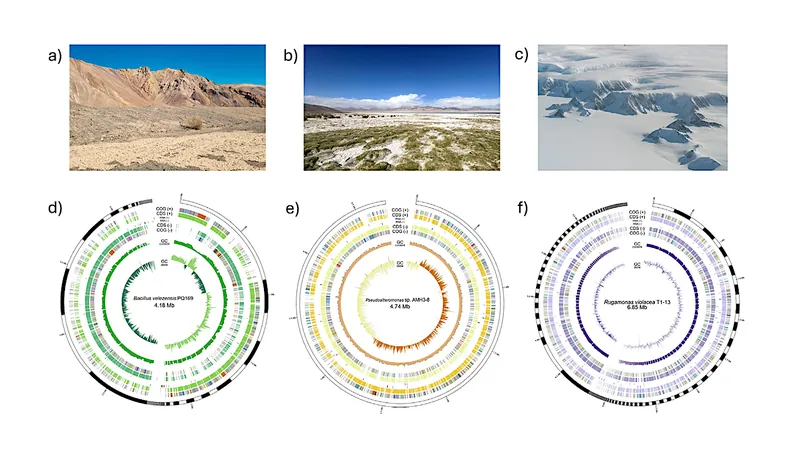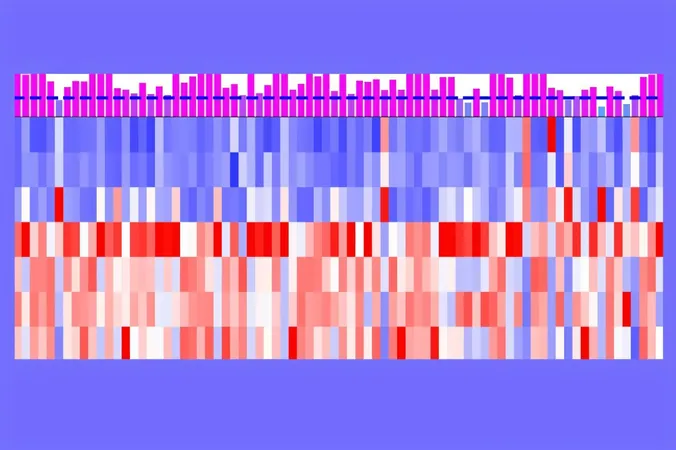
Unlocking Nature's Secrets: How Bacteria from Chile's Harshest Environments Conquer UV Radiation
2025-07-03
Author: Rajesh
Surviving the Extreme: Bacteria's Bold Adaptations
In the unforgiving landscapes of the Atacama Desert, Salar de Huasco, and even Antarctica, certain extremophilic bacteria have crystallized their resilience against intense UV radiation. A groundbreaking study delved into the genetic blueprints of three remarkable bacterial strains—Bacillus velezensis PQ169, Pseudoalteromonas sp. AMH3-8, and Rugamonas violacea T1-13—to unveil how these organisms adapt and thrive under such harsh conditions.
Deciphering the Codes of Survival
By employing integrative genomic analyses, researchers uncovered critical genes integral to DNA repair, pigment production, and the formation of spores. A fascinating look into the phylogenetic relationships among proteins involved in nucleotide excision repair (NER) revealed enduring evolutionary traits, highlighting the essential roles these genes play across various bacterial species.
Shining a Light on DNA Repair Mechanisms
Detailed structural modeling of photolyases from Pseudoalteromonas sp. AMH3-8 and R. violacea T1-13 shed light on the functionalities of these proteins, pivotal for DNA repair and UV defense. Particularly intriguing is R. violacea T1-13's complete violacein operon, illustrating how pigment biosynthesis serves as a formidable shield against harmful radiation.
Sporulation: A Tactical Retreat?
Within B. velezensis PQ169, researchers pinpointed the full suite of genes linked to sporulation—a strategy that could be a vital safeguard against the environmental stresses faced by these bacteria. This discovery suggests that sporulation might be one of the key defensive tactics employed by these microscopic warriors.
Implications for Biotechnology and Beyond
This extensive study illuminates the intricate and diverse strategies that microorganisms harness to combat UV stress, hinting at potential biotechnological applications. Understanding these microbial marvels not only expands our knowledge of resilience in extreme environments but also opens doors to innovations in various scientific fields.
Visualizing the Hidden Connections
To further illustrate these findings, researchers created phylogenetic trees based on the amino acid sequences of vital proteins like UvrA, UvrB, and UvrC. Utilizing advanced software tools, they visualized the evolutionary connections, showing how these extremophiles compare with other UV-resistant and pathogenic strains in extreme conditions.
Charting the Terrain of Genetic Diversity
Maps representing the isolation sites of these bacteria provide compelling visual evidence. From the rugged surface of the Atacama Desert to the icy soils of Antarctica, the genomic features of each strain—including variations in genome size and genetic composition—highlight the incredible adaptability of life in extreme conditions. Heatmaps showcasing nucleotide identity further cement their classification within the bacterial tree of life.
This journey into the genetic world of Chilean extremophiles not only captivates the imagination but challenges our understanding of life's resilience. As research continues, who knows what additional secrets these tiny beings may reveal?



 Brasil (PT)
Brasil (PT)
 Canada (EN)
Canada (EN)
 Chile (ES)
Chile (ES)
 Česko (CS)
Česko (CS)
 대한민국 (KO)
대한민국 (KO)
 España (ES)
España (ES)
 France (FR)
France (FR)
 Hong Kong (EN)
Hong Kong (EN)
 Italia (IT)
Italia (IT)
 日本 (JA)
日本 (JA)
 Magyarország (HU)
Magyarország (HU)
 Norge (NO)
Norge (NO)
 Polska (PL)
Polska (PL)
 Schweiz (DE)
Schweiz (DE)
 Singapore (EN)
Singapore (EN)
 Sverige (SV)
Sverige (SV)
 Suomi (FI)
Suomi (FI)
 Türkiye (TR)
Türkiye (TR)
 الإمارات العربية المتحدة (AR)
الإمارات العربية المتحدة (AR)